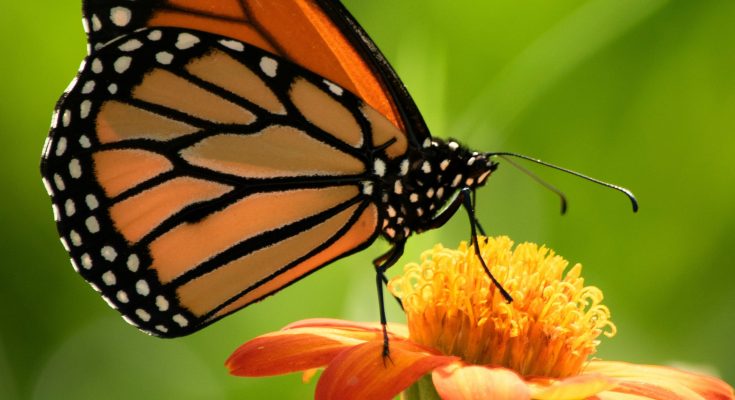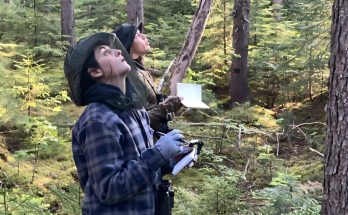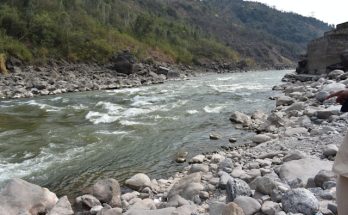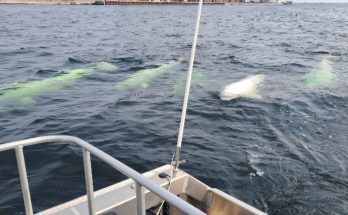Each fall, millions of monarch butterflies fly across Texas skies on their 3,000-mile journey to the mountains of central Mexico. The state’s position in the center of the migratory route makes it critical to the species’ success, both in the spring, when monarchs move north to reproduce, and in the fall, when they travel south to overwinter.
The migration—one of the most remarkable natural events in North America—depends on the habitat, wind patterns and vegetation as guides for the butterflies. At the Texas A&M College of Agriculture and Life Sciences, scientists Robert Coulson, Ph.D., professor in the Department of Entomology, and James Tracy, Ph.D., postdoctoral research associate, are studying how geography, wind and roadside habitat shape those journeys. The goal is to keep migration routes viable, supporting the recovery of monarch populations which have declined by more than 80% since 1990, according to the U.S. Fish and Wildlife Service.
Their research, in partnership with the Texas A&M Transportation Institute and the Texas Department of Transportation, TxDOT, uses science-based mapping and modeling to reduce risks to monarchs during migration and support pollinator health across Texas.
“When you see how many butterflies don’t make the migration, it gives you perspective,” Tracy said. “It shows how closely our daily lives overlap with the natural world, and we are researching some small adjustments that could make a real difference.”
Mapping migration risks
In 2016, Coulson and Tracy began documenting monarch activity along major Texas highways, identifying another major factor in the decline of the monarch: vehicle collisions. From 2018 to 2021, the research team drove thousands of miles each fall, stopping every 30–50 miles to collect butterfly remains and record GPS coordinates.
By combining these field observations with topographic, vegetation and wind data, they created maps showing how geography influences monarch flight in addition to pinpointing where and why collisions were happening.
“It was eye-opening,” Coulson said. “We learned that monarch deaths were concentrated in very specific areas where landforms and wind patterns funneled them.”
Two primary flyways emerged from the data. One runs through central Texas between Wichita Falls and Del Rio, and another along the Gulf Coast. In some areas, food sources like wildflowers and roosting trees along migration routes drew the butterflies closer to roadways. Bridges, causeways and water features often concentrated their flight paths, bringing them even nearer to traffic.
Initial modeling suggested that monarch-vehicle collisions in Texas may account for a significant portion of the species’ overwintering losses, underscoring the need for more refined migration data.
Designing safer crossings
Building on those findings, TxDOT partnered with Texas A&M University to find practical, science-based solutions to reduce collisions. The collaboration became one of the first projects in the country to connect ecological research with transportation management.
Civil engineers Darlene Goehl and Carl Bierman at the Texas A&M Transportation Institute designed and tested “flight diverters,” mesh panels installed near roadways intended to encourage butterflies to fly higher over roadways in hotspots with concentrated monarch roadkill.
The engineers at the Texas A&M-RELLIS campus developed and evaluated prototype diverters to ensure they met highway safety standards and could withstand strong winds. Coulson and Tracy evaluated the efficacy of the prototype diverters in potentially altering monarch flight height above traffic height. The team then installed roadside diverters for field evaluation at two test sites: One in West Texas along Interstate 10 near Ozona and another at the Lavaca Bay Causeway on the Texas coast.
At the West Texas site, early results showed the diverters reduced monarch deaths by about 50% during fall migration. On the coastal causeway, results were less consistent due to wind variability, providing valuable insights into future refinements. Permanent mesh barriers that can remain in place throughout the year are being considered.
“Even modest changes in how roadsides are managed can make a measurable difference,” Tracy said. “That connection between science and application is what makes this work meaningful.”
Understanding habitat interactions
The research also examines how roadside vegetation influences butterfly movement. Milkweed, the only plant monarch caterpillars can eat, and native wildflowers that provide nectar are often found growing in highway ditches and medians. These plants create critical habitat but can also draw butterflies toward traffic.
By mapping milkweed and the related vegetation zones alongside migration data, Coulson’s team also advised TxDOT on potential adjustments to mowing schedules and roadside vegetation management practices to improve habitat with monarch safety in mind.
“Monarchs are an indicator species for broader pollinator health,” Coulson said. “The lessons we learn here are not just for butterflies, but they help bees and other insects essential for agriculture and native ecosystems.”
Coulson explained how a strong monarch migration is a visible sign of a healthy ecosystem. When their numbers drop, it signals broader challenges for pollinators, which are responsible for producing about 1 out of every 3 bites of food we eat. Monarchs pollinate wildflowers and share habitat with bees, flies and beetles supporting Texas agriculture and rangeland productivity. They contribute to the reproduction of native plants that provide forage for livestock and wildlife, as well as many of the crops grown across the state.
Applied research with statewide impact
For Coulson and Tracy, the project exemplifies how applied research can guide conservation and policy in science-backed ways that serve both people and wildlife.
“This is the epitome of what Texas A&M AgriLife does,” Coulson said. “We research and create solutions with practical, usable information and share it with people who can act on it.”
The team’s findings have already influenced how TxDOT and other agencies approach pollinator conservation. Beyond monarchs, their surveys have documented thousands of bees and other butterflies affected by vehicle traffic. The results are helping transportation planners consider pollinator safety when designing and maintaining roadsides.
A migration worth protecting
Each fall, you can find Coulson and Tracy in the field, tracking the monarch migration through Texas, continuing to collect and analyze new data, refining their models and exploring how changing ecosystems and land use may influence future migration routes.
Monarchs connect ecosystems from Canada to Mexico, but their work shows how deeply Texas sits at the epicenter of the migration’s success. The researchers hope to strengthen that connection through data-driven collaboration with state agencies and communities.
“The migration is an incredible natural event,” Coulson said. “There are monarchs around the world, but this large-scale migration is unique to North America. It is something worth seeing and protecting.”
Provided by Texas A&M University





